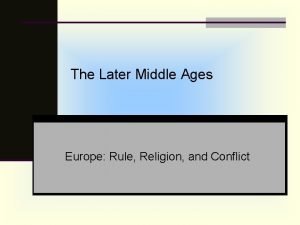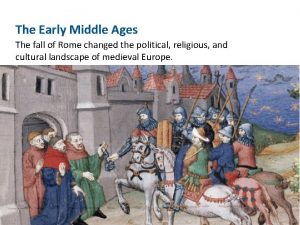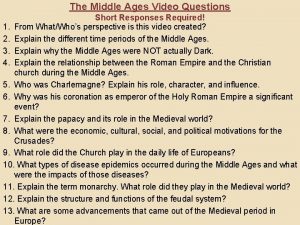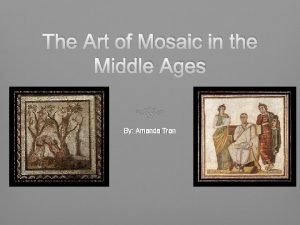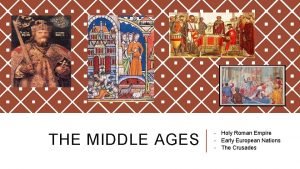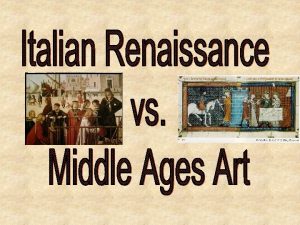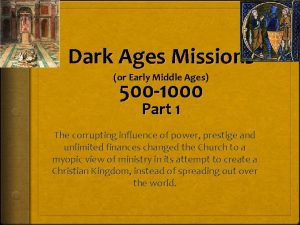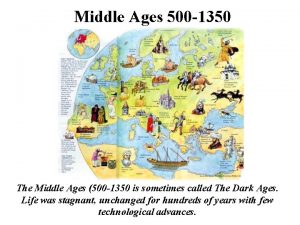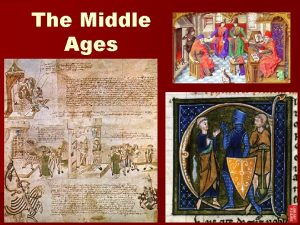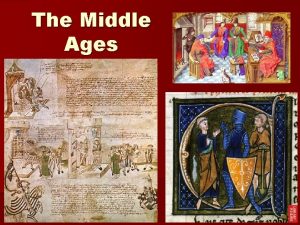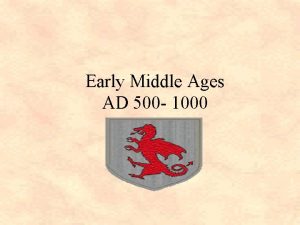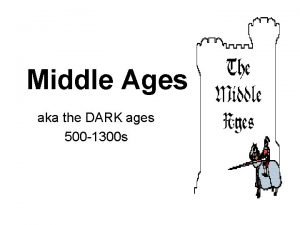Dark Ages Missions or Early Middle Ages 500












- Slides: 12

Dark Ages Missions (or Early Middle Ages) 500 -1000 Part 2 The corrupting influence of power, prestige and unlimited finances changed the Church to a myopic view of ministry in its attempt to create a Christian Kingdom, instead of spreading out over the world.

Nestorians in the East Spread throughout the caravan cities of central Asia to China and beyond. Syrian Christians had a global vision, whereas Western Christians sought to build a Christian Empire By 578 the first recorded Chinese Christian – a monument for their work from 8 th cent discovered in 1625. Well received by Chinese emperor, spread throughout 10 provinces and over 100 cities By 1000 Nestorian Christianity had reached India, Mongolia, Tibet, Korea, China and Japan—Western missions had barely left the empire Remnants of Nestorians found when Franciscans entered China in 1294 Their strict monastic nature prevented them from identifying with the Chinese culture, thus limited their impact Persian Church had 8 million followers by 760, before the Muslim conquest reached their area 2

Christianizing of Europe Britain Strong churches before 300 wiped out by Anglo-Saxon invasions Irish Celtic missionaries re-evangelized Britain from Ireland from island of Iona Pope sent Augustine to convert pagans and Celtics to Roman Christianity by 7 th century Mainland Europe Celtic missionaries spread out in Europe (Columba and Columbanus) starting monasteries Roman missionaries sent to N. Europe to Christianize warring pagan tribes primarily as emissaries of Christian kings (Willibrord and Boniface) Valiant English missionaries attempted to win the Vikings who were raiding their homeland Emperor sends missionaries to Denmark who convert the king Herald Pope and Emperor sent Anskar (801 -865), French monk trained by Columba, to be the official legate to the Swedes, Danes, Slavs of N. Europe. He created a training center to send out missionaries to Scandinavia. 3

Unholy Alliance of Church and State Successful missions were the result of winning the kings to Roman Christianity Sponsors of mission efforts were kings, emperors and popes granting imperial credentials and diplomatic authority to deal directly with the pagan kings. Political leaders saw the financing of Catholic missionaries as practical, rather than conquering pagan states militarily. As nations became “Christian” they could be incorporated into the Christian coalition of the Holy Roman Empire – the missionary became the arm of the state, an instrument of imperialism. Local churches were useless. However, Charlemagne was more interested in his own people becoming Christian, than in a bold mission outreach to Scandinavia – a pivotal mistake that would undo his empire 4

Vikings in the North As Charlemagne consolidate mainland Europe, by 800 the Vikings began to create chaos for the next 250 years The Tribes that invade Rome (400 -600) were mostly Arian Christians – but the Vikings were pure pagans As “men of the sea” they attacked the islands and shorelines where mission training centers and monasteries existed and destroyed everything Christian (churches, monasteries, priests, monks) The captured slaves and forced marriages would eventually evangelize the pagan leaders Viking warriors based in Ireland followed trail of the Peregrini. The wealthier the monastery, the greater the attraction for looting Wherever the Northmen Vikings conquered, they eventually became Christian Normans – this resulted in a new form of Christian culture spreading back to Scandinavia. What Satan means for evil, God turns to His purpose! 5

Islam in the South In 622 Mohammed moved from Mecca to Medina (Hegira) in first step of conquest, which would unite all the Arab tribes by the time of his death in 632. 25 years after his death (657) Islam reached East to Afghanistan and west to Tunisia. By 732 had reached to France. It would take 760 years before Christian Europe was free of Islam (1493) Some reasons for the quick yielding to Islam in N. Africa: 1. Superficial, non-indigenous Christianity of N. Africa 2. Simple monotheistic theology gave hope of wealth and sensual salvation 3. Roman Empire was defenseless due to multiple-front wars (left a power vacuum) 4. Byzantines demanded high taxes for war-costs with Persia 5. Most Middle Eastern and Egyptian Churches were excommunicated anyway 6. People in this area had more in common with Arabs than with Europeans 7. Muslims did not destroy everything; only non-Muslims had to pay taxes 8. Use of statues and Icons appeared polytheistic, thus Islam’s strict monotheism seemed purer Qur’an compiled in final form in 933 By 949 50% of all former Christendom now captured by Islam 6 Mosque in Cordoba, Sp

Rise of the Papal State After the reconquest of Italy from Islam, Italy was devastated Lombards entered Italy from the North, defeated the Byzantine authority leaving Italy vulnerable Pope had Pepin of the Franks crowned “Patrician of the Romans” to secure military aid against Lombards in 754 -6 Pepin’s victory granted the Byzantine Exarchate (seat of Constantinople’s power) to the Papacy (called the “Donation of Pepin”) 7

Rise of the Holy Roman Empire AD 962 Christmas AD 800 Pope Leo III crowned Charlemagne “Emperor of the Romans” Everyone born within his kingdom territory had to become Catholic or be executed Charlemagne ordered the establishing of schools, regulated the clergy Charlemagne’s son and grandsons could not hold the empire together, so it split into France (Charles), Germany (Louis) and the Lowlands (Lothair). As the Carolingian line (from Charlemagne) disintegrated, so the power of the Pope declined – paid tribute to Muslims in South To raise money the church sold high positions 8

Great Schism of the Church Officially divided the Mediterranean Christendom into Eastern (Greek) Orthodox, and Western (Latin) Roman Catholic. Reasons for Split: 1. Controversy over Icons 2. Filioque clause: the procession of the Spirit: “Who proceeds from the Father” in the Nicene Creed -- (Rome added, “and of the Son”) to assure Arians declared a trinity view Personality conflicts between Pope and Patriarch Boundary disputes in the Balkans, S. Italy, and Sicily Prohibition of Icons in the East, rejected in the West Liturgical difference: unleavened bread (West) Celibacy among Western priests Absolute submission to the Papal Primacy and infallibility 3. 4. 5. 6. 7. 8. Resulted in a mutual excommunication in 1054 4 th Crusade when Western army sacked Constantinople 10

Early Reform Movements Bogomilism (968): a dualistic Gnostic Manichaean sect that gave birth to the Cathars and Albigencians in the next centuries Paulicians (872) were a Gnostic Manichaean Christian group opposed the formalism of the Church of Rome Other groups would become dissident groups as corruption and abuses increased but it would be another 300 years before movements began 11 A Bogomil Temple in Bosnia

Key Missionaries Cyril and Methodius Two Greek brothers from Thessaloniki became missionaries to the Slavs of Moravia and Pannonia Studied in Constantinople, became professor of philosophy and theology Devised the Glagolitic or Cyrillic alphabet Little known but their translations and teaching transformed the Slavs Ansgar, Christianized Denmark, Norway, Sweden, but they returned to paganism 12 Slavic worlds

Mission Methods Used Art works and majestic cathedrals gave heavenly experience Civilization was organized in parishes. Bishops authorized priests to preach in rural areas Latin, literature, Bible commentaries, theology had to be taught, thus emperor backed monasteries Military conquest of force conversions Political alliances, wealthy partnerships 13
 Why are the middle ages called the dark ages
Why are the middle ages called the dark ages Renaissance vs medieval art
Renaissance vs medieval art Early middle ages
Early middle ages Early middle ages
Early middle ages Dark ages video questions
Dark ages video questions Mosaic middle ages
Mosaic middle ages Physical education during feudalism
Physical education during feudalism Greek dark ages timeline
Greek dark ages timeline Dark ages def
Dark ages def American cyclopaedia dark ages
American cyclopaedia dark ages Dark ages vs renaissance
Dark ages vs renaissance Holy roman empire def
Holy roman empire def Dark ages vs renaissance
Dark ages vs renaissance


